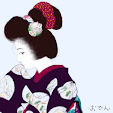It was from an US woman Dale.
She said she recently purchased two items.
But she didn't know what those are.
She guessed the blue jacket is possibly a juban.
And she wanted to know what other item that looks like skirt is.
So, she said us "Can you tell me what these are?".


...No! (>_<;)
They were not Juban, or clothes around kimono.
I got a little shock because it's clear not Japanese things.
Oh...in US, people are lumping Asian countries together...!
...But I reconsidered.
I can't tell European ethnic clothes apart too.
What I have to do is think about her question and give some answer.
It's an inter-cultural communication!
So, I started to research about these old clothes.
I guess it's a Chinese old courtly clothes.
It looks like ethnic clothes of "Qing".
Blue one is men's jacket, and yellow one is women's skirt.
"Qing"[1644-1912] is the last dynasty of China that was under the reign of
Manchurian.
(They're different from the ethnic that now rule China.)
Men's formal suit "Pao".

Men's formal jacket "Gua".

Women's formal two-piece dress "Ruqun".

Skirt of "Ruqun".

One of the way to judge whether the kimono is really old or not is to check if the material is silk or not.
If it's made from chemical fiber, it tend to get static electricity.
And if it's sew & embroidered with hand & silk thread, it's more possibly it's old.
Of course if it's worn-out, it's old.
But some present polyester is so high quality that we can't distinguish it from real silk.
And now, in China, there are some companies that are making very elaborate Qing's clothes for stages, movies, or souvenir.
When I judge kimono's age, I check its design too.
But I don't know about history of Chinese clothes design.
I also can't touch them and judge it is old or not...
I couldn't find enough answer.
However, if it's not fake, it's a noble clothes of 17-20 century's!
Her treasures are very valuable.
I said her these opinions, and I suggested asking museum or university about more informations.
She is looking into Qing's clothes, I guess.
I hope someday she arrive at details about it.
It was my first time to study about Qing culture.
I thank her for giving me a chance!
And I'm looking forward to next questions from her or YOU!


Those are definitely chinese historical clothing although what period I can't tell either.
ReplyDeleteWell done for identifying the era.
In America, it really is a problem that people lump asian countries all together. When I wear Kimono, sometimes people call me Chinese girl, or say "Are you wearing korean girl clothes?" It really is troublesome.
ReplyDeleteIn antique stores, I have even seen Chinese Cheongsam dresses labeled as "Japanese Kimono." It makes me sigh. A lot of people in America that Japan and China and Korea are all basically the same countries (I have had people tell me these things) and it's a little annoying. :\
Kitty Kanzashi, Thank you! :)
ReplyDeleteI think Europeans and Americans are still confusing Asian countries.
except people who has deep knowledge or interest like you.
But I know some people are trying to study about it.
And I also know there are not enough data or materials yet.
This is one of the reason of my building this site & blog. :):)
Jen, Yes, I'm a little disappointed at lack of understanding. (;-;)
ReplyDeleteAnd I'm sad with hearing Chinese Cheongsam dresses are sold as kimono. (Such dresses are called "China Dress" in Japan.)
But I'm glad to know your annoyance!
It means there are at least a few American people who know well about our culture, and are sighing of the wrong. :)
Often we see another countries in stereotype.
A lot of Japanese are thinking American people eat in McDonald's everyday, haha. And almost no Japanese people imagine that there are American who wear kimono!
We can know each other, we're lucky! b(^-^)
As you already know a Kimono is a traditional Japanese robe-like garment that is worn by both men and women. Kimonos are T-shaped, ankle-length garments; they are worn in layers and can be worn casually, formally or anywhere in between.
ReplyDeleteThe dresses look quite ethnic Miao of the Xiangxi Miao dresses during Qing Dynasty.
ReplyDelete